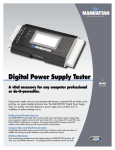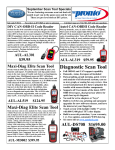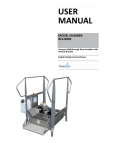Download 48V Battery Maintenance 6
Transcript
48V Battery Maintenance Guide Page 1 Damage will be done to a battery if the voltage drops below 46.0 volts or remains below 48.0 volts for extended periods of time. Battery Level Chart 59.0 volts = Full Battery while charging 51.0 volts = Full Battery 48.0 volts = Low battery 45.0 volts = Dead Battery (Recharge before using again) Exact, optimal numbers will vary with every system It is very important to have enough of charging capacity and low enough usage to bring the battery voltage above 56.0 volts daily, or at least weekly. A full battery is a happy battery ☺ Check the water level of the batteries once every 3 months. Remove the caps on top of the battery. The water level needs to be up to almost the bottom of the plastic lips, and all the metal plates inside the battery need to be well covered with water. If the water level is low, add distilled water. Important: Use only clean water. Water without contaminants or minerals is needed. Use distilled water if in doubt. Add water only when the battery is charged. Adding water to a dead battery will cause it to overflow when it get recharged. ______________________________________ 3376 Harvest Drive Gordonville PA 17529 717-768-7796 A Battery filler jug takes some of the guesswork out of how full to make a battery. It has a nozzle with a valve that fits into the battery-top opening. Press down & when it stops making a bubbling sound, the water level is correct. Battery filler systems are also available, and are ideal for large battery banks. 48V Battery Maintenance Details for the Advanced Do-it-yourselfer Note: Assign these responsibilities to an experienced technician if possible. Page 2 Scheduled battery maintenance programs are available for Lancaster & Dauphin County ≥ 1.290 (Hydrometer reading above 1.290 is too high for most batteries) (Up to 1.30 for industrial batteries) Good Hydrometer reading: ~1.275 ≤ 1.260 (Hydrometer reading below 1.260 is too low for ideal battery health, & life) Use a hydrometer to truly determine how healthy that your battery is. Any reading below ~1.260 on the hydrometer, means that the battery is being starved for power. Increase the charging voltage and/or charging time as needed. (Ideal levels vary by battery type. Readings are to be taken when battery is charged. Consult the user manual for details on your exact battery) General Voltage Setting Guide Consult the battery manufacturer for exact settings on your specific battery. These settings are way off for many batteries. EQ = ~62.0V ~2 hrs. Absorb = ~59.2V ~2 hrs. Float = ~55.2V ~5 hrs. LVD = ~46.0V (Exact, optimal numbers will vary, by how each system gets used) (Flooded batteries only. Not liable for any damage) Upgrade the system if required. If you cannot improve the charging voltage or time with the existing setup, you have three primary options: 1. Increase charging capacity. ☺ 2. Decrease power usage. 3. Suffer from poor system performance & short battery life. " For best results: Consult your solar installer/technician for advice if you plan on adding additional loads to an existing system. Water Type: Adding non-distilled water to a battery can reduce the life of the battery Battery Type: This maintenance guide does not apply to Maintenance-free batteries. A maintenance-free battery does not require water, and may not be charged higher than 14.1 volts. Safety: Contact with battery acid is harmful to the skin and eyes. Wear safety glasses when working with batteries. 3376 Harvest Drive Gordonville PA 17529 717-768-7796







